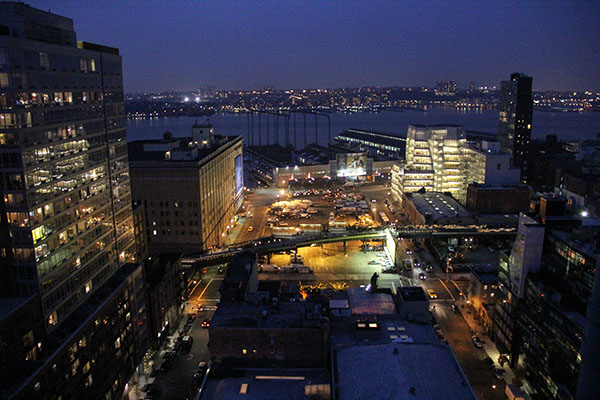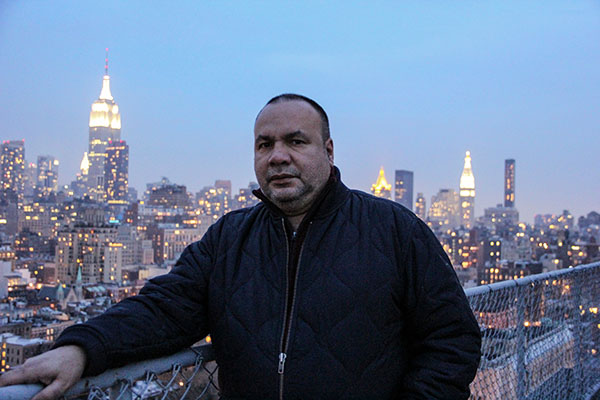
On West 17th Street, between Ninth and Tenth Avenues, there is a rift. One part of the street, at 450 West 17th St., is home to the Caledonia, the self-described, “first luxury residential building on the High Line.” Owned by real estate agency Related Companies, the Caledonia’s upper-floor condominiums are sold out. Rentals on the lower floors cost $4,995 a month for a one-bedroom apartment, and $7,995 for a two-bedroom. Condominiums like it have been cropping up all over Chelsea in recent years; the Caledonia itself opened in 2008.
It is next door to Fulton Houses, the public housing development that runs from West 16th Street to West 19th Street between Ninth and Tenth Avenues. Fulton Houses’ 944 apartments serve middle to low-income tenants: For a two-bedroom unit, some residents say their month’s rent is about $300.
This area of Midtown West has been developing in the last 10 to 20 years, and the speed of gentrification has recently increased. When the New York City Housing Authority (NYCHA), which owns Fulton Houses, Harborview Terrace, Amsterdam Houses, Chelsea Houses and Elliott Houses—the public housing developments in Midtown West—announced at the end of September its plans to build private housing on NYCHA-owned land, it reassured tenants that no current housing developments would be demolished, no public housing residents displaced. And yet many residents remain unconvinced—and worried—that their housing, and affordable housing as a whole, will someday be a thing of the past.
NYCHA’s status as a government agency quells some fears about a developer buying up the land, but not all. Guidelines on the U.S. Department of Housing and Urban Development (HUD) website explain how the demolition or disposition (sale) of a public housing project could happen. According to the site, if “due to a change in the neighborhood, the location of the development is no longer conducive to residential use,” or if “the land on which the development was built is sufficiently valuable that the Public Housing Agency can replace the existing development with an improved development at no cost to HUD,” a sale is possible. It’s policy, not law, that maintains the status quo.
Miguel Acevedo, the president of Fulton Houses Tenant Association, used to believe that NYCHA would never sell public housing properties to private owners. “Five years ago, I would have told you no, no way, no how,” he said. “But now, with so much gentrification that’s going on in this community and housing being so expensive and NYCHA having such a terrible capital budget problem, anything can happen.”
Bob Kalin of Housing Conservation Coordinators, Inc. (HCC) said that it’s “governmental policy that the buildings are developed for public use. There’s no laws that I’m aware of that say that.”
And Rachel Jaffe, HCC staff attorney, confirms that the future of NYCHA housing is an uncertain one, even if the public developments remain. “It’s definitely controversial and this symbolizes the biggest problem in terms of displacement,” said Jaffe, who has also studied urban planning. “NYCHA properties are aging. A lot of them are from the ‘60s. All new NYCHA buildings will be built on the outer reaches [boroughs] of the city. It’ll turn into wealthy Manhattan and Brooklyn, and maybe the poor public housing sections will be on the edges of the city.”

She mentioned that NYCHA may sell one vacant lot in Manhattan for $7 to $10 million. Jaffe also said that the HCC has already seen people getting priced out of the neighborhood in Hell’s Kitchen-Clinton, a trend she expects will continue in Chelsea.
“You’re finding a lot of little stores are getting priced out because their rents are going up,” she said. “Chelsea also has another issue; it’s an aging population that can’t do things … much longer, like go out of the neighborhood to get their needs met. It’s so much more than just housing.”
At 102 years old, Beatrice, who asked that her last name not be used, has been living in Fulton Houses since it was completed in 1965. “That’s when I moved in, the day it opened,” she said. “I’ve been very comfortable here. I have good neighbors. I like the different people all around.”
Sitting on her living room couch, basking in the afternoon sunshine, the white-haired Jewish woman contemplated her history in the area. “I’ve lived here since the 1940s on 12th Street, 20th Street, 27th, all over Chelsea. Oh, I love this neighborhood,” she said.
Housing and tenant activists are watchful; residents see what’s happening around them and share their fears. Keith Rolloen, 40, has lived in Fulton Houses for 15 years. “Most of the residents are afraid of getting pushed out,” he said. “There are already a lot of people moved out. On 14th Street near the fish market, there used to be a supermarket, but now it has become a club.”
Upstairs from Beatrice’s 22nd floor apartment, the Fulton Houses rooftop has the kind of view that attracts a Caledonian price tag—the Hudson River, the High Line Park, the Empire State Building and the new World Trade Center towers.
“Of course they [the condominium residents] think it is unfair. They buy an apartment with one million, and we pay only several hundred a month,” said Acevedo, who works as a superintendent for Cooper Union in the East Village. “Most of the people who moved here back in the 40s and 50s, especially the Hispanic families, they lived on Seventh and Eighth Avenues in the tenement houses. When Fulton Houses was developed, they moved into here to make it affordable for them.”

Developer Artimus Construction will soon build private affordable housing on one of Fulton Houses’ parking lots—literally in the residents’ backyard. But there is no strict definition of “affordable housing” — it could mean that rent prices that are relative to the cost of living in a neighborhood might not differ too dramatically from market rate rents.
“As there’s increased pressure and NYCHA can’t meet its budget,” said Kalin, “it wouldn’t surprise me if they’d try to do this again,” citing the authority’s past attempts to develop more private housing on public land, specifically in Hell’s Kitchen-Clinton.
Gentrification affects not just real estate prices but access to schools, small businesses and government services. “Underserved folks lose access to their local schools,” said Jaffe. And even though “NYCHA housing is sort of protected housing … then they can’t afford to eat, their kids might end up on the subway for an hour in the morning to go to school. They might not have as many resources allocated to their area because it’s not showing up as an underserved area as much.”
Acevedo said that since a developer bought a building near Fulton Houses about three years ago, many small businesses on Ninth Avenue between 17th and 18th Street, which project tenants patronized, have been priced out. “We only got one dry cleaner left, and one deli, that by the end of this year, they have to be out,” he said.
For now, advocates like Acevedo try to do what they can to make sure that low- and middle-income residents won’t be forgotten amid the changes. He has had several victories. Every time a developer wants to build in Chelsea, Community Board 4 requires them a donation to the High Line Park. Acevedo convinced Community Board 4 to allocate $5 million from the Artimus project in the Fulton Houses parking lot to guarantee affordable housing in the new development.
“Anything that goes up, I put my hand in there to make sure they don’t forget that there’s a low income community that resides in this community and we have every right to participate in that,” said Acevedo. He raises eight kids, including his three children and five nephews and nieces, and he’s seen the consequences of gentrification first-hand: Even though his daughter has a good job, she had to move to Astoria because she could not afford to live in the neighborhood where she grew up, her old neighborhood.
Acevedo also runs Fulton Youth For The Future, which started in 2004, and currently has 200 members. His goal is to make these members tech-savvy, to take advantage of the way they can “play video games, use computers and text their friends on the phone at the same time,” he said. He wants them to get trained in the Chelsea Market computer lab, sponsored by Jamestown Properties, to receive college scholarships and eventually to qualify for engineering jobs. Acevedo also teamed up with Dream Hotel to get 10 Fulton Houses residents jobs there since the hotel opened, saying he sees hotels as a good opportunity for employment in the neighborhood.
“It’s easier to be part of the growing gentrification than to sit there and complain about the gentrification,” said Acevedo.